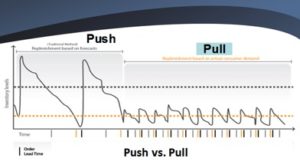Guest Blog by NetPlus Alliance Service Supplier, Howard Coleman, MCA Associates
The Problem with Traditional Inventory Management for Industrial Distributors
…it’s really all about the flow!
…and all about return on investment!
In Part 1, I suggested developing an understanding of the rules of flow in inventory management; what rules need to stay, to go, to change…and which rules need to be added.
The First Law of Flow:
All benefits will be directly related to the speed of product flow and information
What do I mean by “all benefits”?
Those are the things most companies measure and typically emphasize, such as:
Service–A system that flows well will produce consistent and reliable results.
Revenue–When service is consistently high, market share will likely grow or stay consistent.
Inventory–Will be minimized and proportionate to the amount of time it takes to flow between stages and through the total system. The less time it takes to flow through the system, the less the total inventory investment.
Expense–Poor flow results in additional activities and expenses incurred to close the gap in flow. Examples include expedited freight, overtime, rework, unplanned partial shipments or the inability to make a shipment at all.
Cash–If flow is maximized, product is converted to cash more quickly and consistently which positively impacts cash flow.
Return on Investment (ROI)–Obvious…Isn’t that your objective?
Promote and protect the flow of product and information!
Most industrial distributors intuitively grasp the concept of promoting the flow of product and information. Early industrialists like Henry Ford surely did (the assembly line concept is a good example) and he built his business model around it. It only became more difficult as product proliferation occurred. For example, when Henry had to begin making Model T’s with various options and in colors other than black, it became more difficult to foster flow using conventional methods.
Let’s Face It
Wholesale industrial distributors with 15,000 or more stock-keeping-units (SKUs), are faced with a set of circumstances that conventional inventory planning methods, often embedded in their enterprise systems, are not best equipped to handle.
Inventory Distribution Frequency
In the illustration above, doesn’t it look like an aberration of the normal curve? It represents a large number of SKU’s that have too little inventory while still another large number of SKU’s have too much inventory. The smallest number of SKU’s appear to be in a more “optimal zone.” How does your inventory compare to this illustration?
In fact, most SKU’s swing between these zones and can do so over relatively short periods of time, especially when we use traditional inventory planning methods.
Sometimes it may feel as though you are drowning in the data that can force the reactions and necessary actions required to achieve a better balance. Some impacts are very important to realize, while others may not really matter. What is really relevant? This kind of imbalance in optimal inventory negatively impacts the return on your inventory investment, specifically as it relates to:
• Too much of the wrong inventory resulting in unacceptable inventory performance
• Inventory shortages resulting in missed sales
• Unnecessary expenses from expedited and additional freight, overtime, poorly utilized warehousing space, etc. These are all impediments to the protection and promotion of flow. ROI is being compromised!
Part 3: Coming Soon!


